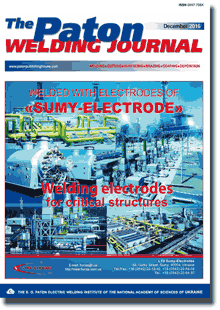| 2016 №12 (09) |
DOI of Article 10.15407/tpwj2016.12.01 |
2016 №12 (02) |

The Paton Welding Journal, 2016, #12, 2-8 pages
Joining parts from shape-memory alloy of Cu–Al system and structural metals by arc-contact welding
B.E. Paton1, D.M. Kaleko1, S.N. Kedrovsky2, Yu.N. Koval2, L.M. Neganov2 and V.N. Slepchenko2
1E.O. Paton Electric Welding Institute, NASU 11 Kazimir Malevich Str., 03680, Kiev, Ukraine. E-mail: office@paton.kiev.ua
2G.V. Kurdyumov Institute for Metal Physics, NASU 36 Acad. Vernadsky Blvd., 03680, Kiev, Ukraine. E-mail: metal@imp.kiev.ua
Abstract
Shape-memory alloys changing part configuration at heating, as well as preserving their elasticity at up to 8–10 % deformation, are becoming ever wider applied in industrial products and apparatuses as thermally-activated elements. Commercial application of alloys of Cu–Al system instead of well-studied alloy of Ti–Ni system (nitinol) allows lowering product cost and expanding the application area up to high temperatures (about 400 °C). Widening the range of products with elements from shape-memory alloys requires studying the possibility of joining metals of this system with structural metals, in particular, with stud-type fasteners. Proceeding from available experience, joints of studs from low-carbon steel of St.3 grade and 12Kh18N9T stainless steel, as well as L63 brass and AMg3 aluminium alloy produced by the methods of arc-contact welding by a capacitor discharge and by DC pulse were studied. Good results were obtained at capacitor welding of studs from the above materials, except for AMg3. The latter is attributable to greater mismatch of thermophysical properties of the metals joined. In DC welding, strong joints were produced only with studs from St.3 steel, because of greater time of welding. It is shown that pulsed welding methods enable preserving functional properties of parts from shape-memory alloys. Inhomogeneity of butt metal structure was found in dissimilar metal welding, which is attributable to short-time existence of the melt (incomplete mixing) and heterogeneity and non-simultaneity of joint cluster solidification. A positive consequence of that is absence of brittle intermetallics of FeAl3 type in the butt and preservation of ductility at deformation of joints with steel studs. 5 Ref., 1 Table, 9 Figures.
Keywords: shape-memory alloys, copper-aluminium alloys, arc-contact welding, structural materials, thermoelastic martensitic transformation
Received: 10.10.16
Published: 24.01.17
References
- Paton, B.E., Kaleko, D.M., Shevchenko, V.P. et al. (2006) Weldability of shape-memory alloys of Ni–Ti system. The Paton Welding J., 5, 2–7.
- Paton, B.E., Kaleko, D.M., Kedrovsky, S.N. et al. (2015) Resistance welding of shape-memory copper-aluminium alloy. Ibid., 12, 2–7. https://doi.org/10.15407/tpwj2015.12.01
- Lebedev, V.K., Kaleko, D.M., Chvertko, N.A. (1994) Development of technology and equipment for arc-contact welding of fastening parts to sheet and other surfaces of items. Proizvodstvo, 4, 14–16.
- Kaleko, D.M., Kononets, B.I., Oseledko, N.N. et al. (1991) Unit K747MB for capacitor-discharge stud welding. Ibid., 6, 25–27.
- Kaleko, D.M., Kedrovsky, S.N., Koval, Yu.N. et al. (2015) Pulsed capacitor-discharge welding of functional alloys based on Cu–Al system and its influence on joint zone structure Metallofizika i Novejshie Tekhnologii, 37(12), 1663–1680.
